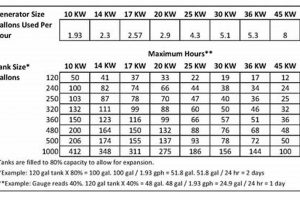These devices offer a convenient source of backup power by converting the chemical energy stored in natural gas into electricity. A typical unit consists of an internal combustion engine fueled by natural gas, connected to an alternator that produces electrical current. This current can then power appliances and devices during outages or in locations lacking grid access. They are often differentiated by their power output, measured in watts or kilowatts, and features such as automatic start functionality and multiple outlets.
Utilizing a readily available fuel source delivered through existing infrastructure, these power solutions provide reliable and comparatively clean energy during critical situations. Historically, backup power relied heavily on gasoline-powered units. The shift towards cleaner-burning and readily-available natural gas represents a significant advancement in portable power generation, reducing both environmental impact and fuel storage concerns. This makes them a compelling choice for homeowners, businesses, and emergency services.
The subsequent sections will explore the various types available, key considerations for selection and installation, safety precautions, and the evolving role of these generators within the broader energy landscape.
Tips for Using Natural Gas Portable Generators
Safe and efficient operation requires careful planning and adherence to specific guidelines. The following tips offer practical advice for maximizing the benefits and minimizing potential risks.
Tip 1: Professional Installation: Ensure installation is performed by a qualified technician. Proper connection to the gas supply and electrical system is critical for safety and optimal performance.
Tip 2: Ventilation: Operate the generator in a well-ventilated area to prevent carbon monoxide buildup. Never run it indoors or in enclosed spaces.
Tip 3: Regular Maintenance: Adhere to the manufacturer’s recommended maintenance schedule. This typically includes oil changes, air filter replacements, and spark plug inspections.
Tip 4: Proper Fuel Connection: Verify the natural gas connection is secure and leak-free. Conduct periodic checks for any signs of damage or wear.
Tip 5: Load Management: Avoid overloading the generator. Calculate the total wattage of connected devices and ensure it remains within the generator’s rated capacity.
Tip 6: Grounding: Proper grounding is essential for electrical safety. Follow the manufacturer’s instructions to ensure the generator is correctly grounded.
Tip 7: Storage: Store the generator in a dry, protected location when not in use. Protect it from extreme temperatures and moisture.
By following these precautions, users can ensure safe and reliable operation, maximizing the lifespan of their equipment while mitigating potential hazards.
This proactive approach to operation and maintenance ensures optimal performance and contributes significantly to long-term reliability and safety.
1. Fuel Source
Natural gas serves as the primary energy source for these generators, offering distinct advantages over other fuels like gasoline or propane. The combustion of natural gas within the generator’s engine drives the alternator, producing electricity. This reliance on natural gas offers several benefits, including reduced emissions compared to gasoline-powered counterparts and connection to existing residential or commercial natural gas lines, eliminating the need for refueling and ensuring a continuous supply during extended outages. This makes them particularly suitable for locations with readily available natural gas infrastructure.
The use of natural gas as a fuel source contributes significantly to the overall efficiency and practicality of these generators. For instance, homeowners can connect their generator directly to their home’s natural gas line, ensuring uninterrupted power during emergencies. Similarly, businesses can rely on these generators to maintain critical operations during power disruptions, minimizing financial losses. The stable fuel supply offered by natural gas lines eliminates the logistical challenges associated with storing and replenishing liquid fuels, enhancing operational reliability. Moreover, the relatively clean combustion of natural gas contributes to a reduced environmental footprint compared to generators utilizing other fossil fuels.
In summary, the utilization of natural gas as a fuel source significantly impacts the functionality and practicality of these generators. Direct connection to existing natural gas lines provides a reliable and continuous fuel supply, while the cleaner combustion contributes to reduced emissions. These advantages make natural gas-powered generators a compelling choice for various applications where reliable and environmentally conscious power generation is paramount. However, considerations regarding natural gas infrastructure availability and installation costs remain relevant factors in determining the suitability of these generators for specific contexts.
2. Portability
Portability is a defining characteristic that distinguishes these generators from permanently installed standby units. This mobility allows users to deploy power generation capabilities precisely where and when needed, offering significant advantages in various scenarios. Unlike their stationary counterparts, portable units can be easily transported to locations lacking grid access, providing power for construction sites, remote work locations, or outdoor events. Furthermore, portability facilitates crucial backup power during emergencies, enabling homeowners and businesses to maintain essential operations during grid outages. This flexibility is a key advantage, ensuring power availability regardless of location or circumstance.
Consider a contractor working on a remote building project without access to electricity. A portable generator provides the necessary power to operate tools and equipment, enabling continued progress. Similarly, in the aftermath of a natural disaster, these units can power essential appliances in homes and businesses, providing critical support during recovery efforts. For recreational purposes, they offer a reliable power source for camping trips or outdoor gatherings. These real-world examples illustrate the practical value of portability in diverse contexts.
The convenience of mobility extends beyond mere transportability. Compact designs and integrated features, such as wheels and handles, further enhance portability, enabling easy maneuverability and deployment by a single individual. This ease of use is a crucial factor contributing to the widespread adoption of these generators across various sectors. However, it is essential to acknowledge that portability can also introduce challenges, such as the need for manual refueling and potential limitations in power output compared to larger, stationary units. Understanding these trade-offs is crucial for informed decision-making when selecting a generator for specific needs.
3. Power Output
Power output, measured in watts or kilowatts, is a critical factor defining the capabilities of a natural gas portable electric generator. This output determines the number and types of devices the generator can power simultaneously. Understanding the power requirements of intended loads is essential for selecting a generator with adequate capacity. Insufficient power output leads to overloading, potentially damaging the generator and connected devices. Conversely, an excessively large generator represents unnecessary expenditure and fuel consumption. The reliability of this electricity hinges on consistent fuel supply and proper generator maintenance, ensuring dependable power during outages or off-grid operations.
Consider a homeowner needing backup power for essential appliances during a power outage. Refrigerators, sump pumps, and lighting represent critical loads requiring a generator with sufficient output to handle their combined wattage. In a different scenario, a construction crew using power tools at a remote site requires a higher output generator capable of sustaining the demands of heavy-duty equipment. These examples illustrate the direct relationship between power output and the practical applications of portable generators. Calculating the required wattage and selecting a generator with appropriate capacity are essential steps for ensuring reliable and safe operation.
Matching power output to specific needs is crucial for optimal performance and safety. While larger generators offer greater capacity, they also come with increased fuel consumption and cost. Smaller, more fuel-efficient models suffice for less demanding applications. Careful consideration of power requirements, combined with an understanding of generator types and features, ensures informed decision-making, resulting in a reliable power source tailored to specific circumstances. Neglecting power output considerations can lead to operational inefficiencies, equipment damage, or even safety hazards. Therefore, accurate load assessment and appropriate generator selection are paramount for maximizing the benefits of portable power generation.
4. Safety
Safe operation of natural gas portable electric generators is paramount due to the inherent risks associated with combustion byproducts and electricity generation. Carbon monoxide (CO) poisoning poses a significant threat. This odorless, colorless gas is a byproduct of combustion and can accumulate in poorly ventilated areas, leading to serious health consequences or even fatalities. Proper ventilation is crucial. Operating the generator outdoors, far from windows, doors, and vents, minimizes CO exposure. Electrical hazards also require attention. Proper grounding and dry operation prevent shocks and electrocution. Ignoring these precautions can have dire consequences, highlighting the critical link between safety practices and responsible generator use.
Consider a scenario where a generator is operated indoors during a power outage. Lack of ventilation allows CO to build up, potentially exposing occupants to dangerous levels. In another instance, using a damaged extension cord with the generator can create an electrocution hazard. These examples illustrate the practical significance of safety precautions. Regular maintenance, including inspections for leaks and damage, is essential for preventing accidents. Understanding the potential dangers and adhering to safety guidelines mitigates risks and ensures user well-being. Further, awareness of local regulations regarding generator usage contributes to overall community safety.
In summary, safe operation hinges on a thorough understanding and consistent application of essential precautions. Addressing potential hazards, such as CO poisoning and electrical shocks, through proper ventilation, grounding, and regular maintenance is crucial. Neglecting these safety measures risks serious consequences, underscoring the direct link between responsible operation and user well-being. Ultimately, prioritizing safety transforms these powerful tools from potential hazards into reliable sources of power during emergencies and off-grid operations.
5. Applications
The versatility of natural gas portable electric generators drives their diverse applications across various sectors. From residential backup power to industrial operations and recreational activities, these generators provide reliable electricity in situations where grid access is unavailable, unreliable, or cost-prohibitive. This adaptability stems from their portability, fuel efficiency, and relatively clean operation compared to gasoline-powered alternatives. Understanding these varied applications highlights the significant role these generators play in modern society, supporting essential services, facilitating economic activities, and enhancing leisure pursuits. The ability to provide on-demand power independent of the electrical grid underscores their practical significance in diverse contexts.
Residential users rely on these generators for backup power during outages, ensuring essential appliances continue to function. This capability provides critical support for life-sustaining equipment like medical devices, heating systems, and refrigeration, safeguarding health and well-being during emergencies. In construction and industrial settings, these generators power tools and machinery in locations lacking grid access, enabling continued operations and project completion. Furthermore, their portability makes them invaluable for disaster relief efforts, providing power for communication systems, medical facilities, and temporary shelters in affected areas. These real-world examples demonstrate the practical impact of their diverse applications. From maintaining essential services to facilitating economic activities and supporting emergency response, these generators play a crucial role in ensuring continuity and resilience across various sectors.
The diverse applications of natural gas portable electric generators contribute significantly to their overall value proposition. While challenges such as noise levels and emissions remain considerations, ongoing technological advancements aim to mitigate these concerns. As reliance on reliable power sources continues to grow, these generators offer a practical and increasingly sustainable solution for a wide range of applications. Understanding the breadth of these applications and the evolving technological landscape underscores the continued importance of these devices in meeting the evolving power needs of modern society.
Frequently Asked Questions
This section addresses common inquiries regarding natural gas portable electric generators, providing concise and informative responses to facilitate informed decision-making and safe operation.
Question 1: What are the primary advantages of using natural gas as a fuel source?
Natural gas offers convenient accessibility through existing infrastructure, eliminating the need for fuel storage and refueling. Its cleaner combustion produces fewer emissions compared to gasoline, contributing to reduced environmental impact.
Question 2: How is the power output of a generator determined, and why is it important?
Power output, measured in watts or kilowatts, indicates the generator’s capacity to power electrical devices. Accurate assessment of load requirements is crucial for selecting a generator with adequate output, preventing overload and ensuring reliable operation.
Question 3: What safety precautions are essential when operating a natural gas portable generator?
Operating the generator outdoors in a well-ventilated area is crucial to prevent carbon monoxide poisoning. Proper grounding is essential to mitigate electrical hazards. Consulting the manufacturer’s instructions provides comprehensive safety guidelines.
Question 4: What maintenance procedures are recommended for optimal generator performance and longevity?
Regular maintenance, as outlined in the manufacturer’s guidelines, typically includes oil changes, air filter replacements, and spark plug inspections. Adherence to these procedures ensures optimal performance and extends the generator’s lifespan.
Question 5: How does portability enhance the usability of these generators?
Portability allows deployment in various locations lacking grid access, providing power for construction sites, emergency situations, or recreational activities. This flexibility enhances their practical value and expands their range of applications.
Question 6: What factors should be considered when selecting a natural gas portable electric generator?
Key considerations include power output requirements, fuel type, portability needs, safety features, and budget constraints. Careful evaluation of these factors ensures selection of a generator that aligns with specific needs and circumstances.
Understanding these key aspects of natural gas portable electric generators empowers informed decision-making, promoting safe and efficient operation while maximizing the benefits of this versatile power solution.
The following section delves further into the specific types of natural gas portable generators available on the market.
Conclusion
This exploration of natural gas portable electric generators has highlighted their significance as reliable and versatile power sources. From emergency preparedness to off-grid operations and recreational activities, these devices offer a practical solution for diverse power needs. Key considerations encompassing power output, fuel efficiency, portability, safety features, and maintenance requirements underscore the importance of informed decision-making for optimal generator selection and operation. The advantages of natural gas as a cleaner and readily available fuel source further contribute to the appeal of these generators within the evolving energy landscape.
As technology continues to advance, further enhancements in efficiency, emissions reduction, and noise mitigation are anticipated. The increasing demand for reliable and sustainable power solutions positions natural gas portable electric generators as valuable assets for both residential and commercial applications. Careful consideration of individual needs, coupled with adherence to safety guidelines and proper maintenance practices, will ensure the continued effectiveness and longevity of these essential power generation tools.





